by Maurice Hirsch, Adv.
Israel has the right under international law to Israel apply its civilian law to these areas.
Introduction
Israel has announced that it will apply Israeli civilian law to areas of Judea, Samaria and the Jordan Valley, (the area renamed “the West Bank” by Jordan after 1948), on or after July 1, 2020. Whereas this is seen by some as a hurried political decision, the more fundamental question is, does Israel have the right to do this under international law?
The answer to this question is a clear – Yes.
Historical-legal status of Judea, Samaria and the Jordan Valley 1517- 2020
From 1517 until 1917, the entire area of Israel, including Judea, Samaria and the Jordan valley was part of the Ottoman Empire. During this period, no independent sovereign state existed in the area.
In 1916, anticipating the end of the WWI, representatives of the British and French empires made an agreement, with the concurrence of the Russian Empire, to divide control over the Middle East between them. The agreement, known as the "Sykes – Picot Agreement" divided the spheres of influence and control in much of the Middle East between the two empires according to following map:
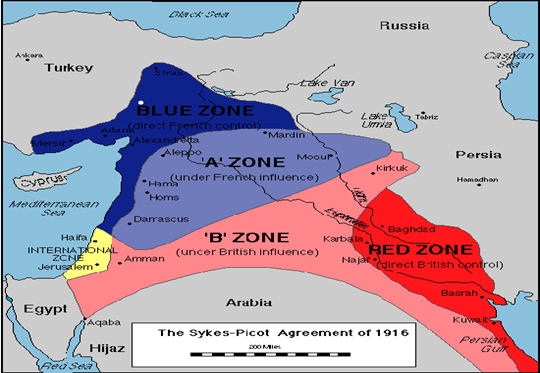
In 1917, the British government issued the Balfour Declaration:
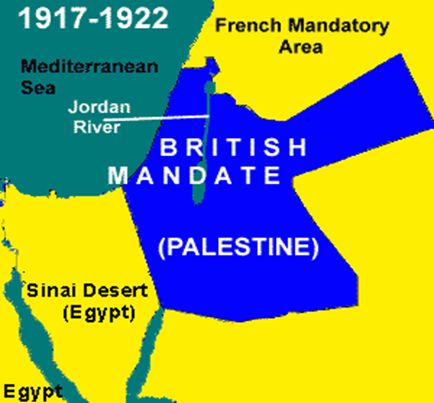
The San Remo resolution was entrenched in the 1922 League of Nations Mandate for Palestine.
The preamble to the Mandate reaffirmed the Balfour Declaration and once again confirmed the historical connection of the Jewish people to the Land of Israel by stating:
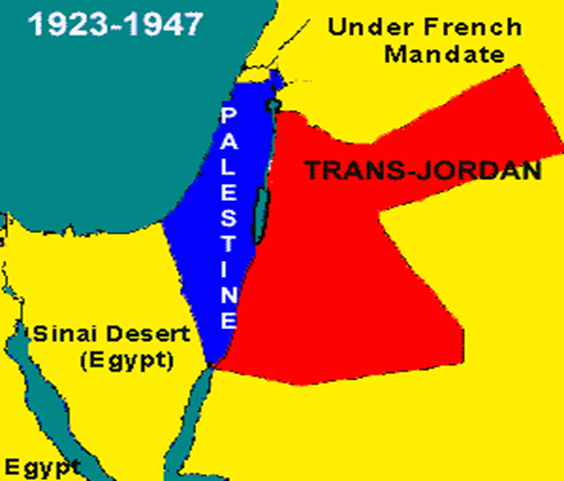
While Article 80 of the newly convened United Nations (which replaced the League of Nations) Charter preserved the rights of the Jewish people granted in the Mandate, in the aftermath of World War II, the UN again addressed the question of the Palestine. Having considered the different recommendations submitted, on November 29 1947, the General Assembly of the UN adopted resolution 181, known as the "Palestine Partition Plan". This resolution sought to divide the remaining territory of Palestine into two new states – a Jewish state and an Arab state – setting the new boundaries of the nascent states, as can be seen in the following illustration:
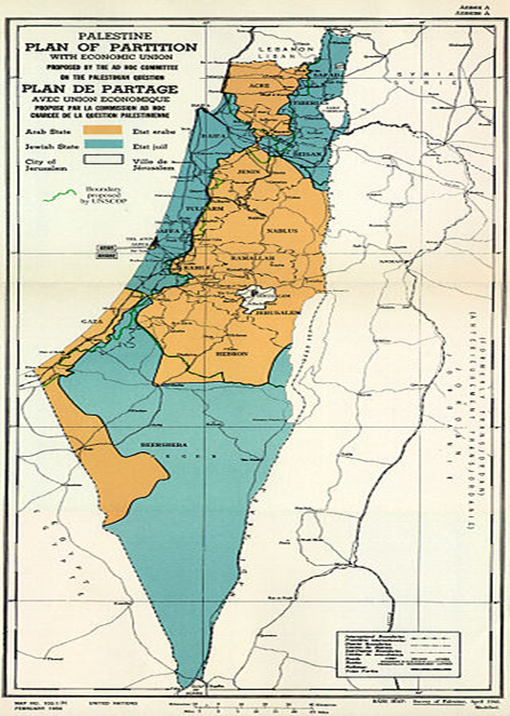
No reference to the term “The West Bank” appears in the UN Partition Plan. In fact, when delineating the boundaries of the “Arab State”, the resolution specifically refers to “The boundary of the hill country of Samaria and, Judea starts on the Jordan River”.
While the representatives of the Jewish People accepted the Partition Plan, the Arab representatives and the surrounding Arab countries rejected the plan in its entirety and started active preparations to seize the entire area by military force. The response of the Arab representatives and countries made implementation of UNGA Resolution 181 impossible and it was never confirmed by the UN Security Council.
On May 14 1948, Israel declared its Independence without specifying its borders. The new State was immediately attacked by a coalition of 5 Arab states as well as Arab forces in the former Mandate territory, who collectively strived to wipe it out. The Egyptian forces attacked from the south, the Lebanese and Syrian forces attacked from the north and the Jordanian forces, accompanied by Iraqi forces attacked from the east.
The Jordanian forces attacked and occupied Judea, Samaria and the Jordan Valley, then calling them, for the first time, "the West Bank". The Jordanian forces who occupied the area, destroyed the Jewish communities that existed, killing or expelling their residents.
In 1949, Israel concluded “Armistice” agreements with the neighboring Arab countries. The armistice agreement with Jordan, provided that the demarcation lines drawn would under no circumstances be considered as "borders".
Thus Article II.2 of the armistice agreement stated:
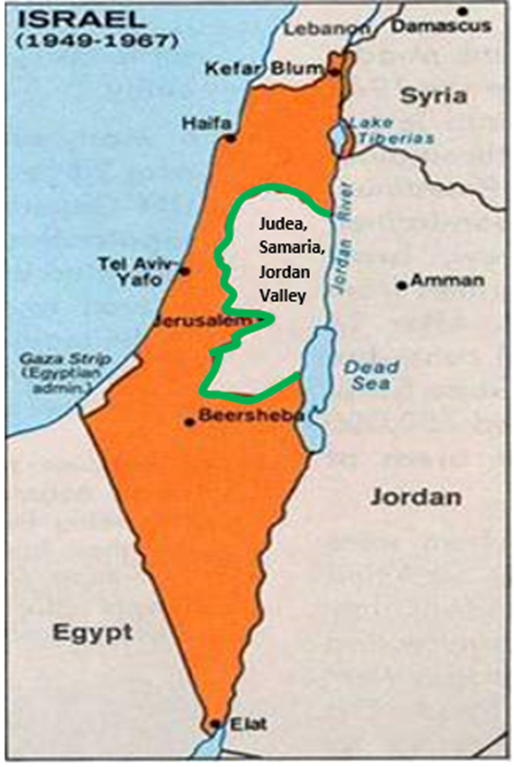
A Jordanian attempt to annex Judea, Samaria and the Jordan Valley was rejected by the international community.
Article 24 of the original 1965 Palestine Liberation organization (PLO) Charter provided that “This Organization [The PLO] does not exercise any territorial sovereignty over the West Bank in the Hashemite Kingdom of Jordan, on the Gaza Strip or in the Himmah Area”.
In June 1967, Jordan again attacked Israel. Defending itself against the attack, Israel expelled the Jordanian occupiers, and seized control of Judea, Samaria and the Jordan Valley.
Several months after the end of the Six day War, on November 22, 1967 the UN adopted resolution 242. This resolution, often erroneously cited as requiring Israel to retreat to the pre-1967 borders, in fact read as follows:
While earlier drafts had proposed withdrawal by Israel from “the territories occupied” the word “the” was removed from the final resolution as adopted by the Security Council so as to signify that a full withdrawal by Israel to the armistice lines established in 1949 would not be required.
Since 1967, Israel administered Judea, Samaria and the Jordan Valley through a Military Commander. In contrast, shortly after the Six Day War, Israel applied its civilian law to extensive areas of Jerusalem.
The application of Israeli civilian law to Judea, Samaria and the Jordan Valley should not be defined as “Annexation” since it is not being carried out at the expense of another state. According to Rainer Hofmann in the Max Plank Encyclopedia of International Law, "Annexation means the forcible acquisition of territory by one State at the expense of another State… Annexation is in contrast to acquisition a) of terra nullius [Latin for "nobody's land"]…” [Emphasis added]
Israel has announced that it will apply Israeli civilian law to areas of Judea, Samaria and the Jordan Valley, (the area renamed “the West Bank” by Jordan after 1948), on or after July 1, 2020. Whereas this is seen by some as a hurried political decision, the more fundamental question is, does Israel have the right to do this under international law?
The answer to this question is a clear – Yes.
- The League of Nations allocated all of Israel, including these areas, for the purpose of establishing the Jewish National Home in 1922. No other internationally recognized instrument has superseded that decision;
- The Arab countries and most of the Arabs resident in British Mandate controlled Palestine, rejected the 1947 UN partition plan, so it has no relevance today under international law.
- No other country has a legal claim to that territory;
- No state border has ever separated Judea, Samaria and the Jordan Valley from the rest of Israel;
- The application of Israeli law to Judea, Samaria and the Jordan Valley should not be referred to as “Annexation”, since annexation is the acquisition of territory by one State “at the expense of another State”.
Historical-legal status of Judea, Samaria and the Jordan Valley 1517- 2020
From 1517 until 1917, the entire area of Israel, including Judea, Samaria and the Jordan valley was part of the Ottoman Empire. During this period, no independent sovereign state existed in the area.
In 1916, anticipating the end of the WWI, representatives of the British and French empires made an agreement, with the concurrence of the Russian Empire, to divide control over the Middle East between them. The agreement, known as the "Sykes – Picot Agreement" divided the spheres of influence and control in much of the Middle East between the two empires according to following map:

In 1917, the British government issued the Balfour Declaration:
“His Majesty's Government view with favour the establishment in Palestine of a national home for the Jewish people, and will use their best endeavors to facilitate the achievement of this object, it being clearly understood that nothing shall be done which may prejudice the civil and religious rights of existing non-Jewish communities in Palestine or the rights and political status enjoyed by Jews in any other country.” [emphasis added]Meeting in April 1920, in San Remo, Italy, to discuss the future of the former territories of the Ottoman Empire, the principal allies who defeated the Germans and the Ottomans resolved that some areas would become states. As regards “Palestine”, the allies resolved:
“the Mandatory will be responsible for putting into effect the declaration originally made on the [2nd] November, 1917, by the British Government and adopted by the other Allied Powers, in favour of the establishment in Palestine of a national home for the Jewish people”.At the time, “Palestine” was comprised of both Israel (including Judea, Samaria and the Jordan Valley) and the territory that is today Jordan.

The San Remo resolution was entrenched in the 1922 League of Nations Mandate for Palestine.
The preamble to the Mandate reaffirmed the Balfour Declaration and once again confirmed the historical connection of the Jewish people to the Land of Israel by stating:
"Whereas the Principal Allied Powers have also agreed that the Mandatory should be responsible for putting into effect the declaration originally made on November 2nd, 1917, by the Government of His Britannic Majesty, and adopted by the said Powers, in favor of the establishment in Palestine of a national home for the Jewish people, it being clearly understood that nothing should be done which might prejudice the civil and religious rights of existing non-Jewish communities in Palestine, or the rights and political status enjoyed by Jews in any other country;In 1923, pursuant to Article 25 of the Mandate, a decision was made to divide Mandatory Palestine into two entities – "Palestine" that lay to the west of the Jordan river and "Trans-Jordan" which would in time (1946) be recognized as the Hashemite Kingdom of Jordan. The provisions of the Mandate for establishing the Jewish National Home, including through the settlement of Jews on the land, continued to apply in the entire area to the west of the Jordan river. The following map illustrates this division:
Whereas recognition has thereby been given to the historical connection of the Jewish people with Palestine and to the grounds for reconstituting their national home in that country." [emphasis added]

While Article 80 of the newly convened United Nations (which replaced the League of Nations) Charter preserved the rights of the Jewish people granted in the Mandate, in the aftermath of World War II, the UN again addressed the question of the Palestine. Having considered the different recommendations submitted, on November 29 1947, the General Assembly of the UN adopted resolution 181, known as the "Palestine Partition Plan". This resolution sought to divide the remaining territory of Palestine into two new states – a Jewish state and an Arab state – setting the new boundaries of the nascent states, as can be seen in the following illustration:

No reference to the term “The West Bank” appears in the UN Partition Plan. In fact, when delineating the boundaries of the “Arab State”, the resolution specifically refers to “The boundary of the hill country of Samaria and, Judea starts on the Jordan River”.
While the representatives of the Jewish People accepted the Partition Plan, the Arab representatives and the surrounding Arab countries rejected the plan in its entirety and started active preparations to seize the entire area by military force. The response of the Arab representatives and countries made implementation of UNGA Resolution 181 impossible and it was never confirmed by the UN Security Council.
On May 14 1948, Israel declared its Independence without specifying its borders. The new State was immediately attacked by a coalition of 5 Arab states as well as Arab forces in the former Mandate territory, who collectively strived to wipe it out. The Egyptian forces attacked from the south, the Lebanese and Syrian forces attacked from the north and the Jordanian forces, accompanied by Iraqi forces attacked from the east.
The Jordanian forces attacked and occupied Judea, Samaria and the Jordan Valley, then calling them, for the first time, "the West Bank". The Jordanian forces who occupied the area, destroyed the Jewish communities that existed, killing or expelling their residents.
In 1949, Israel concluded “Armistice” agreements with the neighboring Arab countries. The armistice agreement with Jordan, provided that the demarcation lines drawn would under no circumstances be considered as "borders".
Thus Article II.2 of the armistice agreement stated:
“It is also recognised that no provision of this Agreement shall in any way prejudice the rights, claims and positions of either Party hereto in the ultimate peaceful settlement of the Palestine question, the provisions of this Agreement being dictated exclusively by military considerations”Article VI.9 of the same agreement provided:
“The Armistice Demarcation Lines defined in articles V and VI of this Agreement are agreed upon by the Parties without prejudice to future territorial settlements or boundary lines or to claims of either Party relating thereto.”The armistice lines would then become known as the “Green Line”.

A Jordanian attempt to annex Judea, Samaria and the Jordan Valley was rejected by the international community.
Article 24 of the original 1965 Palestine Liberation organization (PLO) Charter provided that “This Organization [The PLO] does not exercise any territorial sovereignty over the West Bank in the Hashemite Kingdom of Jordan, on the Gaza Strip or in the Himmah Area”.
In June 1967, Jordan again attacked Israel. Defending itself against the attack, Israel expelled the Jordanian occupiers, and seized control of Judea, Samaria and the Jordan Valley.
Several months after the end of the Six day War, on November 22, 1967 the UN adopted resolution 242. This resolution, often erroneously cited as requiring Israel to retreat to the pre-1967 borders, in fact read as follows:
"The Security Council,Resolution 242 does not require Israel to withdraw from all of "the territories occupied” but rather calls for a just and lasting peace which should include both withdrawal by Israel from "territories occupied" and “respect for and acknowledgement of the sovereignty, territorial integrity and political independence of every State in the area and their right to live in peace within secure and recognized boundaries free from threats or acts of force".
Expressing its continuing concern with the grave situation in the Middle East,
Emphasizing the inadmissibility of the acquisition of territory by war and the need to work for a just and lasting peace in which every State in the area can live in security,
Emphasizing further that all Member States in their acceptance of the Charter of the United Nations have undertaken a commitment to act in accordance with Article 2 of the Charter,
Affirms that the fulfillment of Charter principles requires the establishment of a just and lasting peace in the Middle East which should include the application of both the following principles:
1) Withdrawal of Israeli armed forces from territories occupied in the recent conflict;
2) Termination of all claims or states of belligerency and respect for and acknowledgement of the sovereignty, territorial integrity and political independence of every State in the area and their right to live in peace within secure and recognized boundaries free from threats or acts of force;
Affirms further the necessity
1) For guaranteeing freedom of navigation through international waterways in the area;
2) For achieving a just settlement of the refugee problem;
3) For guaranteeing the territorial inviolability and political independence of every State in the area, through measures including the establishment of demilitarized zones;
Requests the Secretary General to designate a Special Representative to proceed to the Middle East to establish and maintain contacts with the States concerned in order to promote agreement and assist efforts to achieve a peaceful and accepted settlement in accordance with the provisions and principles in this resolution;
Requests the Secretary-General to report to the Security Council on the progress of the efforts of the Special Representative as soon as possible.” [emphasis added]
While earlier drafts had proposed withdrawal by Israel from “the territories occupied” the word “the” was removed from the final resolution as adopted by the Security Council so as to signify that a full withdrawal by Israel to the armistice lines established in 1949 would not be required.
Since 1967, Israel administered Judea, Samaria and the Jordan Valley through a Military Commander. In contrast, shortly after the Six Day War, Israel applied its civilian law to extensive areas of Jerusalem.
The application of Israeli civilian law to Judea, Samaria and the Jordan Valley should not be defined as “Annexation” since it is not being carried out at the expense of another state. According to Rainer Hofmann in the Max Plank Encyclopedia of International Law, "Annexation means the forcible acquisition of territory by one State at the expense of another State… Annexation is in contrast to acquisition a) of terra nullius [Latin for "nobody's land"]…” [Emphasis added]
Maurice Hirsch, Adv.
Source: https://palwatch.org/page/18009
Follow Middle East and Terrorism on Twitter
No comments:
Post a Comment